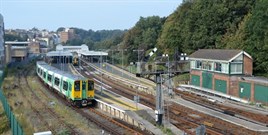“I want it to come forward,” she responds. “It’s now about the signalling. I’m continuing to press for it. We have been talking to other rail consultancy firms to bring it forward.”
For an extension of HS1 to happen, Rudd talks of a redesign of Ashford station. There is also mention of a consultancy firm talking to main stakeholders about their views.
More pressingly, she’s concerned about current journey times. With an election around the corner, politicians are keen to have their name attached to any improvements.
“Why does Hastings-London have to stop at so many stations?” she asks.
There is also talk of Southeastern running a Hastings express (an 0804 fast to Tunbridge Wells with an 0934 arrival at Charing Cross), but that train hasn’t appeared in the timetable just yet. Rudd’s desire to see HS1 trains is expressed, alongside her frustration at the “appalling” Southeastern during recent winters, with particular discontent for the operator’s “poor communication”.
She tells RAIL: “Everyone talks about regeneration. That means economic growth. It’s also about improving other elements of the town. Schools want to recruit teachers. It’s about broadening options.” Not least of which is the dualling of the A21 between Tonbridge and Pembury, itself costing £70 million, with work due to start this spring.
Additionally, as Hastings Council’s Birch notes, the cost of going to overhead wires will add to the cost of any upgrade scheme for Hastings-Ashford.
Rudd’s Labour opponent Sarah Owen is hoping to take the parliamentary seat at May’s General Election. She’s concerned about the wider transport issues in the area.
“Everyone of any political persuasion has asked for a decent direct rail link between Hastings and London,” she tells RAIL. “But as well as looking at train services we need a combined transport network with our buses as well.”
For Owen, there is an issue about whether people can rely on the local bus network to and from a train connection in “a town which is incredibly hilly”, with different parts of the community quite spread out.
She refers to earlier proposals to better connect the town via the line to Tonbridge - constrained in places by several Victorian tunnels being too narrow for modern trains to pass, as British Rail was unable to re-engineer them.
“A lot of smaller stations would kick up considerable fuss if they were ever bypassed for a faster route, so the only viable option for a better route to London is via Ashford,” she says.
“I am pleased that NR has done a report into the extension of HS1, but we’ve not seen the full details of it. It’s quite difficult to get the detail that elected members have access to, because I’m a candidate and not the MP.
“We’re all pretty supportive of the idea, but now’s the time to ask how it’s going to be funded and delivered. What sort of service can we expect?
“It’s all very well having a plan for the future, but commuters right now are suffering. If you look at the route from Hastings-Ashford there are a number of smaller stations. Communities now are very concerned. Some certainty for them is needed.
“We need electrification of that railway, but we also need something that is fit for the future. We don’t want to be having this discussion in 20 or 30 years’ time.”
Owen believes it’s not just the line that needs investment, but also the rolling stock itself, although she’d probably find little sympathy with other parts of the country having to use 1980s vintage DMUs.
“We have had a severe lack of investment in our trains. HS1 would be the ideal for me. But we’ve got to get a solution quickly, and economically. We need to know where NR places Hastings and HS1 in its priority list. We want to give commuters a reasonable expectation.”
As the 19th most deprived borough in the UK, Hastings is not an excessively wealthy place, and Owen remarks: “Where do we fit in the priorities down south in Hastings? What do we need to do to bump ourselves up?”
While supportive of a better rail service, Owen’s priority is a “smoother, more reliable, much quicker service that is value for money” - and HS1 could literally be the vehicle for that.
Looking at Hastings, its geography and the potential of its connections to London, it’s not inconceivable that it could become another Brighton - with the right infrastructure in place. Indeed, there’s evidence to suggest that people are already being priced out of an area that has ben dubbed ‘Islington-on-Sea’, and taking up the opportunity of cheaper property in Hastings, even if the job opportunities are more limited.
As Ray Chapman, of the St Leonards and Hastings Rail Improvement Programme (SHRIMP), says: “The real issue for Hastings is that we are not attracting businesses to the town because of that poor connectivity. But we think this probably fits in with CP6 unless there are creative ideas from suppliers such as getting NR down here sooner without blocking other developments.”
Birch agrees: “If the business case and technical case add up - we’re assuming this would be post-2019, early-2020s. But it won’t happen before 2019.”
NR tells Birch that this is because of the physical delivery, particularly signalling, but he counters: “There could be two General Elections before then, so the people offering the absolute commitment might not be in office.”
- This feature was published in RAIL 766 on 21 January 2015













Login to comment
Comments
No comments have been made yet.